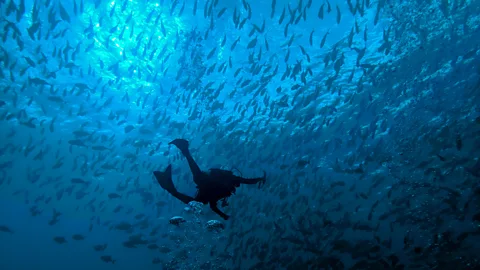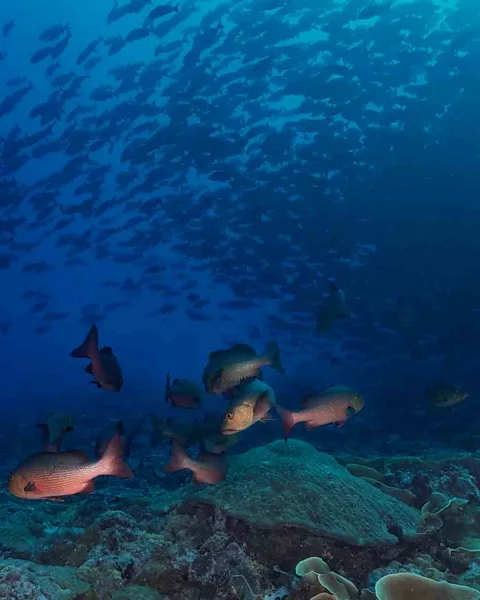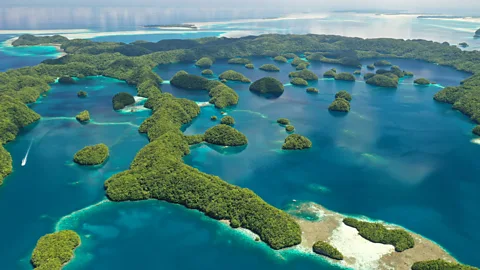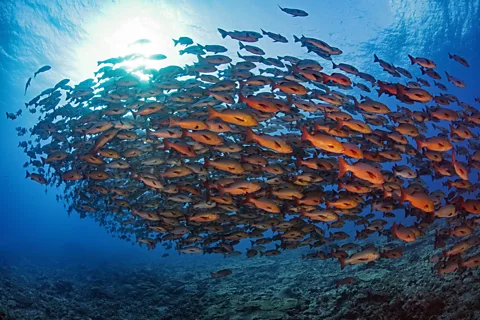What it's like to scuba dive in the South Pacific's most inexplicable feeding frenzy
 Suzie Dundas
Suzie DundasThe full Moon is a mating call for one of the ocean's most extraordinary phenomena, when thousands of red snapper gather in what can only be described as a frenzied fish orgy.
At 06:00, our small boat was floating a few miles from shore in the island nation of Palau, the early morning sun occasionally reflecting off the gentle curve of the waves. Eight divers were perched on the side of the boat, backs out, wetsuits on, scuba diving air valves fully open. But we were in a holding pattern, heads bobbing from both surface swells and lingering fatigue. Though ours were drooping, our captain's eyes were fixed on the point where our scuba diving guide had submerged minutes prior. The objective: locating Lutjanus bohar, commonly known as red snapper.
But one fish wouldn't do — we were looking for at least 1,000. Five thousand would be better.
Suddenly, our guide's hand shot skyward, indicating he'd spotted what had brought us to this place at this time: an amorphous, ephemeral mass of snapper that regularly spawn at this particular dive site, called Shark City.
A quick reverse count from three, and we backrolled into the water as one unit, quickly descending to 31m below the surface. The depth put us eye to bulging fish eye with one of Palau's most inexplicable marine phenomena: a snapper spawning aggregation, a breathtaking ballet of nature driven by an unknown biological code.
Here, three days before the full Moon every month, these fish gather in what can only be described as a frenzied fish orgy. As the tide turned, the shimmering sphere of bodies grew denser, becoming roughly the size of a football field as it moved toward the surface. As if on cue, the females released their eggs, triggering a flurry of activity from the males as they darted through the massive school in a hectic attempt to maximise fertilisation — and a flurry of movement from divers as we tried to keep up with the action. We ascended with the fishy mass, not knowing where to look and attempting to clumsily adjust our underwater cameras before the influx of genetic material clouded the otherwise-clear water.
 Shinto K Anto
Shinto K AntoThis weirdly specific, oddly appealing mating event likely unfolds in oceans around the world, but Palau's two sites — Shark City, and one near Peleliu Island – are the only known fixed locations where red snapper spawnings happen on a regular basis and are accessible to divers. And with recreational divers limited to depths of about 20m, and advanced divers to no more than 40m, finding spawnings is no easy task.
"There are probably sites like that every 10 or 20 miles but we just don't know where they are," said Mandy Etpison of NECO Marine dive shop in Palau's capital city of Koror. As the first PADI-certified instructor in Palau in 1985, Etpison helped pioneer the island's then-nascent dive industry and has authored several books on its ecology. She recalls that it was 2009 when a local dive shop confirmed two of the island’s best known spawning phenomena: red snapper near the full Moon at a dive site called Shark City, where we were; and bumphead parrotfish around the new Moon at a nearby site called Ulong Sandbar.
How to see Palau's fish spawnings
Palau's red snapper and bumphead spawnings take place at dive sites around Shark City and Ulong Channel; both are approximately a 45-minute boat ride from the mainland. Most dive shops offer spawning dive trips, but travellers may also want to consider a liveaboard scuba diving boat, allowing you to sleep onboard near the sites. Established land-based operators include NECO Marine and Fish 'n Fins Palau, while the Black Pearl, Ocean Hunter and the Palau Siren liveaboards offer spawning-focused multi-day dive trips.
Since then, research on reef fish behaviour has been minimal. Scientists think fertilisation coincides with the start of the outgoing current to maximise the dispersal of eggs into the open ocean. But the question of how these fish navigate this complex dance, how they pinpoint the exact time and location to spawn, remains a mystery.
"I don't know if there's really been any work on that yet. They get cues from the Moon, I think," said Christina Muller-Karanassos, who leads the fisheries research projects at Palau's International Coral Reef Research Center. "At spawns, you get some immature fish that follow bigger fish to the site. So maybe they learn."
 Jack Fishman
Jack FishmanEven the discovery of most spawning aggregations happens by accident, either based on reports from fisherman or "just by dumb luck", as Etpison says, as Palau dive operators look for new sites to help disperse the growing number of dive tourists. "So it's just more eyes in the water."
For scientists, data collected during the few aggregation studies underway will guide future marine conservation efforts in Palau, a country with rare species like dugongs and ancient nautilus. In addition, scientists have found that several of the country's 700 coral species seem resistant to bleaching, which they hope to study to learn how to protect other coral species around the world.
In 2009, the same year the snapper and bumphead spawnings were confirmed, Palau created the world's first shark sanctuary, banning the fishing of 350 shark species in an area the size of France. In 2015, more than 80% of that area became the Palau National Marine Sanctuary (PNMS), which banned offshore fishing of any type starting a few miles offshore around Palau's islands. Currently under consideration is a fisheries management plan to tighten regulations in the water immediately offshore, which is part of the shark reserve, but not part of the sanctuary. The plan proposes measures such as complete bans on fishing specific species — like red snapper — and restrictions on fishing around known spawning grounds for three days before and after spawns occur.
Who can dive
Palau's red snapper spawning dives are for experienced divers. Most dive shops recommend at least 50 logged dives; Etpison recommends at least 100. Divers should know how to manage swells and down currents and should be comfortable with speedy descents to advanced depths. Less-advanced divers may want to instead experience Palau's shallower bumphead snapper spawns. The bumphead spawns occur during the new Moon and typically have more predictable currents and calmer surface conditions.
"A lot of the time, these are also commercially important fish, and it's so easy to catch them during an aggregation. So protecting them is extremely important," Muller-Karanassos said. "If you fish them all out, then you're not going to have those top predators there, so the food web will be off."
 Getty Images
Getty ImagesWitnessing Palau's red snapper spawning aggregations are as much about luck as anything else. Though our liveaboard dive schedule was centred around the spawnings, we missed it on our first attempt, diving in about 20 minutes too early. Beforehand, we'd been taught how to use metal reef hooks to counteract the currents, but our claw-shaped hooks easily detached from their formerly secure holds in the rocky bottom each time the swells shifted direction. The spawn happens around sunrise but the precise timing can fluctuate, and the gas blends in our diving cylinders limited us to about 20 minutes at the 30m depth before we needed to begin our ascent. Fortunately, we caught the spawning on the next day's attempt.
Luckily for us – or not, depending on one's proclivity for sharks – we were not the only voyeurs on the second day of the fishy bacchanal.
The undersea phenomenon acts as a siren song for apex predators, drawing everything from opportunistic great barracuda and common gray reef sharks to larger open-ocean species like oceanic black tip and bull sharks. "They're just focused on the fish," Etpison says of bull sharks, though she cautions that divers ought not to get between them and the snapper.
Indeed, on our spawning dive, we saw not one but two bull sharks circling on the outskirts of the action. For all we know, they were there the entire time, but we weren't able to see them through the density of fish, sperm and egg. Fortunately, they were on the opposite side of us as the spawning, closer to the open ocean.
That may capture the essence of diving in Palau. Thanks to the shark sanctuary and marine conservation zones, efforts like the Palau Pledge (a sustainability mandate visitors must stamp in their passports) and the continued efforts of diving operators to lobby for responsible tourism, no dive has a singular draw. A dive to a manta cleaning station will also be packed with sea turtles; a dive through an underwater cavern may include the chance to spot the natural flashing lights of the aptly named "disco clam". The rarity of seeing the bull sharks or a snapper spawning would be the clear highlight of a dive trip anywhere else in the world. But in Palau, it’s just another day on the reef.
--
If you liked this story, sign up for The Essential List newsletter – a handpicked selection of features, videos and can't-miss news, delivered to your inbox twice a week.
